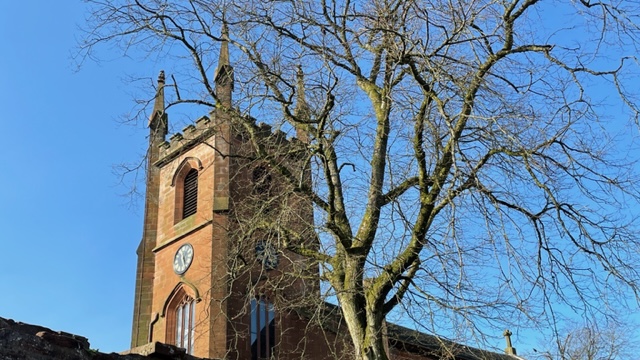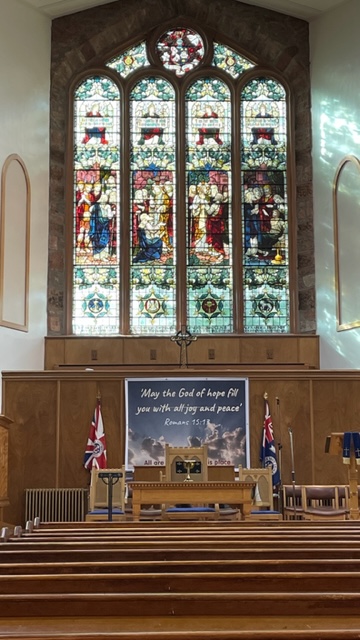
The present church was opened for public worship in August 1829.
It stands on the site of St Michael’s Church which dates back to the thirteenth century and which was granted parochial status by the Bishop of Glasgow in 1315.
St Michael’s Parish Church stood on land belonging to Melrose Abbey and in those days the parish comprised the present parishes of Mauchline, Sorn and Muirkirk.
Protestantism, in Mauchline, was greatly aided by visits to the parish by two of the Reformation’s most influential figures.
In 1544 George Wishart, finding the doors of the Church barred against him, preached for almost three hours on Mauchline Muir.
Following his return from exile in France and Switzerland in 1599, John Knox preached at Kingencleugh.
It was to Robert Campbell of Kingencleugh that Knox entrusted the care of his widow and children.
When the Scottish Parliament adopted the Confession of Faith in 1560 the Reformation was immediately accepted in Mauchline.

The former St.Michael’s Church taken down in 1827 after being in use for about 630 years.
This was the church Robert Burns knew.
Dismissed by some as “extremely contemptible” others regarded it as a “tabernacle that was beautiful to the eye’.
Our church is also an area of special note, for anyone who has an interest in Robert Burns.
Burns lived in Mauchline from March 1784 – November 1786, and in that time made many friends, and wrote some of his most famous poems.

The present interior of the Church dates from the mid 1950’s when extensive renovations had to be carried out due to the discovery of dry rot.
Above the entrance to the church, you will see an inscription, and on either side at the top of the entrance is a gargoyle. At the rear right-hand side of the building there is a memorial plaque to the Very Rev. Dr. Joseph Mitchell, minister of the parish from 1890 until 1930 and Moderator of the last General Assembly before the Union of the Church of Scotland and the United Free Church in 1929.
The organ was built by Willis in 1888 for Strathbungo Parish Church, Glasgow.
It was gifted and installed in 1980 with a legacy bequeathed by the Rev. A. Stewart the last Minister of Mauchline North Church.
At this time the chancel was also refurbished.
The stained-glass window was erected in 1903 and is dedicated to the memory of Major General Sir Claud Alexander, Bart. of Ballochmyle.
It has four lights which portray the story of Christ and the Centurion.
The silver Baptismal Basin was gifted in 1788 by the Honourable Lady Anne Whitefoord in acknowledgement of the many happy years she had spent in Mauchline under the excellent instruction of the then minister, the Rev. William Auld ( “Daddie Auld” of Robert Burns ‘ The Kirk’s Alarm’)
In this connection the Church still has in its possession the Kirk Session Minute Book relating to the Burns era.
In June 1786 Burns appeared before the Session and admitted his responsibility for Jean Armour’s pregnancy and, as a result, both had to appear in Church on three occasions to receive public rebuke.
Two years later both again appeared before the Session when it was agreed that their marriage should he regularised.
In this way Burns made peace with the Church and gave a guinea note for the relief of the poor.



The Covenanters’ Flag was first used in an engagement between Covenanters and Royalist troops on Mauchline Muir and was later carried at the Battles of Drumclog and Bothwell Brig in 1679.
That Mauchline was a Covenanters’ stronghold can be seen from the fact that the minister, the Rev. George Young. signed the National Covenant in Greyfriars’ Churchyard in Edinburgh in 1638 and subscribed to the Solemn League and Covenant in 1643.
The flag was handed over to the Kirk Session for safe keeping in 1955 and thereafter gifted to the congregation in 1980. The Covenanters’ Flag is now framed and hung on the south wall of the church.
The wrought iron celtic cross , the The wrought iron font stand in the chancel and the flag holder now supporting the British Legion colours were all made and gifted to the church by a local craftsman.